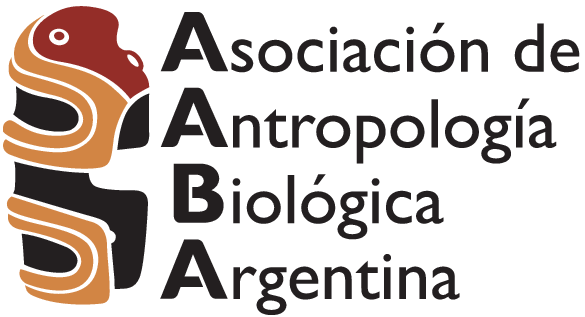Cambios degenerativos articulares de la columna torácica con respecto al sexo y la edad
DOI:
https://doi.org/10.24215/18536387e054Palabras clave:
vértebras, porosidad, osteofitosis, eburnación, osteoartritisResumen
La columna vertebral torácica manifiesta cambios degenerativos por envejecimiento, obesidad, actividad repetitiva y estrés ocupacional, aunque las diferencias por sexo son poco conocidas. Examinamos si existen diferencias en la expresión de los cambios articulares degenerativos en las vértebras torácicas en mujeres y hombres con respecto a la edad. Los dos grupos de edad incluidos en el análisis corresponden a adultos maduros entre 50 y 55 años y entre 70 y 75 años pertenecientes a la colección osteológica William M. Bass de la Universidad de Tennessee, Knoxville (EEUU). El primer intervalo representa el inicio del declive esqueletal, mientras que el segundo está relacionado con una movilidad reducida y un aumento en el dolor articular. Se examinaron macroscópicamente las vértebras torácicas de 99 individuos (52 mujeres y 47 hombres) en las articulaciones superiores e inferiores de los cuerpos y en las zigapófisis, relevando la presencia de osteofitos, porosidad y eburnación según el sistema de puntuación no métrico de Buikstra y Ubelaker (1994). Tanto los individuos femeninos como los masculinos de mayor edad presentan una mayor severidad en los cambios degenerativos que los adultos mayores, y para los hombres el grado de osteofítos fue extremo. Para los adultos mayores, los hombres presentan una mayor severidad de osteofítos, extensión de osteofítos, porosidad y extensión de la porosidad, que las mujeres. Sin embargo, las mujeres presentan un mayor grado de eburnación, particularmente en las vértebras torácicas inferiores. Cuando se comparan los adultos mayores, los hombres expresan un mayor grado de osteofitosis, extensión de osteofitos y extensión de la porosidad, que las mujeres. Al igual que sus contrapartes de mayor edad, las mujeres adultas maduras muestran evidencia de una mayor severidad en eburnación que los hombres, lo que sugiere que la alteración del perfil hormonal asociada con el cese reproductivo de las mujeres, así como el estrés ocupacional, pueden afectar el deterioro de los discos intervertebrales, particularmente en el esqueleto torácico inferior.
Descargas
Referencias
Austin, A. E. (2017). The cost of a commute: A multidisciplinary approach to osteoarthritis in New Kingdom Egypt. International Journal of Osteoarchaeology, 27, 537-550. https://doi.org/10.1002/oa.2575
Battié, M. C., Videman, T., Kaprio, J., Gibbons, L. E., Gill, K., Manninen, H., Saarela, J. & Peltonen, L. (2009). The twin spine study: Contributions to a changing view of disc degeneration. Spine Journal, 9(1), 47-59. https://doi.org/10.1016/j.spinee.2008.11.011
Becker, S. L. & Goldstein, P. S. (2018). Evidence of osteoarthritis in the Tiwanaku colony, Moquegua, Peru (AD 300-1100). International Journal of Osteoarchaeology, 28, 54-64. https://doi.org/10.1002/oa.2634
Benquist, M. (2003). Natural history of the aging spine. In: M. Aebi, R. Gunzburg and M. Szpalski (Eds.),The Aging Spine (pp. 4-7). Berlin: Springer.
Brennaman, A. L., Love, K. R., Bethard, J. D. & Pokines, J. T. (2017). A Bayesian approach to age-at-death estimation from osteoarthritis of the shoulder in modern North Americans. Journal of Forensic Sciences, 62, 3. https://doi.org/10.1111/1556-4029.13327
Bridges, P. S. (1994). Vertebral arthritis and physical activities in the prehistoric southeastern United States. American Journal of Physical Anthropology, 93(1), 83-93. https://doi.org/10.1002/ajpa.1330930106
Buikstra, J. E. & Ubelaker, D. H. (1994). Standards for Data Collection from Human Skeletal Remains. Fayetteville, Arkansas: University of Arkansas.
Burkhardt, A. & Grupe, G. (2018). Hydroxylysine deficiency, conspicuous skeletal lesions and a strange burial practice in a historical German island population. International Journal of Osteoarchaeology, 28, 227-236. https://doi.org/10.1002/oa.2649
Calce, S. E., Kurki, H. K., Weston, D. A. & Gould, L. (2017). Principal component analysis in the evaluation of osteoarthritis. American Journal of Physical Anthropology, 162(3), 476-490. https://doi.org/10.1002/ajpa.23130
Chen, D., Shen, J., Zhao, W., Wang, T., Han, L., Hamilton, J. L. & Im, H. J. (2017). Osteoarthritis: Toward a comprehensive understanding of pathological mechanism. Bone Research, 5(1), 1-13. https://doi.org/10.1038/boneres.2016.44
Cook, D. C., Buikstra, J. E., DeRousseau, C. J. & Johanson, D. C. (1983). Vertebral pathology in the Afar australopithecines. American Journal of Physical Anthropology, 60(1), 83-101.
Felson, D. T. (2003). Epidemiology of osteoarthritis. In K. D. Brandt, M. Doherty and L. S. Lohmander (Eds.), Osteoarthritis (pp. 9-16). New York: Oxford University Press.
Gibbon, V. E., Gallagher, A. & Huffman, T. N. (2014). Bioarchaeological analysis of Iron Age human skeletons from Zambia. International Journal of Osteoarchaeology, 24, 100-110. https://doi.org/10.1002/oa.2231
Goldring, S. R. & Goldring, M. B. (2006). Clinical aspects, pathology and pathophysiology of osteoarthritis. Journal of Musculoskeletal and Neuronal Interactions, 6(4), 376-378.
Henderson, C. Y., Craps, D. D., Caffell, A. C., Millard, A. R. & Gowland, R. (2013). Occupational mobility in 19th century rural England: The interpretation of entheseal changes. International Journal of Osteoarchaeology, 23, 197-210. https://doi.org/10.1002/oa.2286
Jurmain, R. D. (1977). Stress and the etiology of osteoarthritis. American Journal of Physical Anthropology, 46(2), 353-365.
Jurmain, R. D. (1990). Paleoepidemiology of a central California prehistoric population from Ca-Ala-329. II. Degenerative disease. American Journal of Physical Anthropology, 83(1), 83-94.
Knüsel, C. J., Göggel, S. & Lucy, D. (1997). Comparative degenerative joint disease of the vertebral column in the medieval monastic cemetery of the Gilbertine Priory of St. Andrew, Fishergate, York,England. American Journal of Physical Anthropology, 103(4), 481-495.
Larsen, C. S. (2015). Bioarchaeology: Interpreting Behavior from the Human Skeleton. Cambridge: Cambridge University Press.
Listi, G. A. & Manhein, M. H. (2012). The use of vertebral osteoarthritis and osteophytosis in ageestimation. Journal of Forensic Sciences, 57(6), 1537-1540. https://doi.org/10.1111/j.1556-4029.2012.02152.x.
Loeser, R. F. (2009). Aging and osteoarthritis: The role of chondrocyte sequences and aging changes in the cartilage matrix. Osteoarthritis and Cartilage, 17(8), 971-979. https://doi.org/10.1016/j.joca.2009.03.002
Loeser, R. F. (2010). Age-related changes in the musculoskeletal system and the development of osteoarthritis. Clinics in Geriatric Medicine, 26(3), 371-386. https://doi.org/10.1016/j.cger.2010.03.002
López-Barrales, R., Hubbe, M., Aspillaga, E., Neves, W. A. & Niemeyer, H. M. (2015). Osteofitosis vertebral en poblaciones prehispánicas de San Pedro de Atacama, norte de Chile. Estudios Atacameños: Arqueología y Antropología Surandinas, 50, 177-194. https://doi.org/10.4067/S0718-10432015000100009
Maat, G. J., Mastwijk, R. W. & van der Velde, E. A. (1995). Skeletal distribution of degenerative changes in vertebral osteophytosis, vertebral osteoarthritis and DISH. International Journal of Osteoarchaeology, 5(3), 289-298.
Marklein, K. E., Leahy, R. E., & Crews, D. E. (2016). In sickness and in death: Assessing frailty in human skeletal remains. American Journal of Physical Anthropology, 161(2), 208-225. https://doi.org/10.1002/ajpa.23019
Mays, S. A. & Dungworth, D. (2009). Intervertebral chondrocalcinosis: An exercise in differential diagnosis in paleopathology. International Journal of Osteoarchaeology, 19, 36-49. https://doi.org/10.1002/oa.973
McGonagle, D., Tan, A. L., Carey, J. & Benjamin, M. (2010). The anatomical basis for a novel classification of osteoarthritis and allied disorders. Journal of Anatomy, 216(3), 279-291. https://doi.org/10.1111/j.1469-7580.2009.01186.x
Molnar, P., Ahlstrom, T. P. & Leden, I. (2011). Osteoarthritis and activity-an analysis of the relationship between eburnation, musculoskeletal stress markers (MSM) and age in two Neolithic hunter-gatherer populations from Gotland, Sweden. International Journal of Osteoarchaeology, 21, 283-291.https://doi.org/10.1002/oa
Nevitt, M. C. & Felson, D. T. (1996). Sex hormones and the risk of osteoarthritis in women: Epidemiological evidence. Annals of the Rheumatic Diseases, 55(9), 673-676.
Ortner, D. J. (2003). Osteoarthritis and diffuse idiopathic skeletal hyperostosis. In D. J. Ortner (Ed.), Identification of Pathological Conditions in Human Skeletal Remains (pp. 545-560). Cambridge: Academic Press.
Palmer, J. L. A., Hoogland, M. H. L. & Waters-Rist, A. L. (2016). Activity reconstruction of post-medieval Dutch rural villagers from upper limb osteoarthritis and entheseal changes. International Journal of Osteoarchaeology, 26, 78-92. https://doi.org/10.1002/oa.2397
Pariente, E., Olmos, J. M., Landeras, R., Nan, D., Gonzalez-Macias, J. & Hernandez, J. L. (2017). Relationship between spinal osteoarthritis and vertebral fractures in men older than 50 years: Data from the Camargo Cohort Study. Journal of Bone and Mineral Metabolism, 35(1), 114-121. https://doi.org/10.1007/s00774-016-0735-1
Plomp, K. A., Roberts, C. A. & Strand Viđardottir, U. (2015). Morphological characteristics of healthy and osteoarthritic joint surfaces in archaeological skeletons. International Journal of Osteoarchaeology, 25, 515-527. https://doi.org/10.1002/oa.2319
Quispe, B. I. & Williams, F. L. (2019). Cervical arthritis, C3-C7, from an identified osteological collection. Revista Argentina de Antropología Biológica, 21(1), 1-13. https://doi.org/10.17139/raab.2019.0021.01.04
Roberts, A. M., Robson-Brown, K., Musgrave, J. H. & Leslie, I. (2006). A case of bilateral scapholunate advanced collapse in a Romano-British skeleton from Ancaster. International Journal of Osteoarchaeology, 16, 208-220. https://doi.org/10.1002/oa.817
Robson-Brown, K., Pollintine, P. & Adams, M. A. (2008). Biomechanical implications of degenerative joint disease in the apophyseal joints of human thoracic and lumbar vertebrae. American Journal of Physical Anthropology, 136, 318-326. https://doi.org/10.1002/ajpa.20814
Rogers, J. & Dieppe, P. (2003). Paleopathology of osteoarthritis. In K. D. Brandt, M. Doherty and L. S. Lohmander (Eds.), Osteoarthritis (pp. 57-65). New York: Oxford University Press.
Rothschild, B. M. (1997). Porosity: A curiosity without diagnostic significance. American Journal of Physical Anthropology, 104(4), 529-533.
Schaffer, W. C., Carr, R. S., Day, J. S. & Patemen, M. P. (2012). Lucayan-Taíno burials from Preacher’s Cave, Eleuthera, Bahamas. International Journal of Osteoarchaeology, 22, 45-69. https://doi.org/10.1002/oa.1180
Shirley, N. R., Wilson, R. J. & Jantz, L. M. (2011). Cadaver use at the University of Tennessee’s Anthropological Research Facility. Clinical Anatomy 24(3), 372-380. https://doi.org/10.1002/ca.21154
Snodgrass, J. J. (2004). Sex differences and aging of the vertebral column. Journal of Forensic Sciences, 49(3), 458-463.
Solomon, L. (2001). Clinical features of osteoarthritis. In: S. Ruddy, E. Harris Jr. and C. Sledge (Eds.),
Kelley’s Textbook of Rheumatology (pp. 1409-1418). Philadelphia: Saunders. Srikanth, V. K., Fryer, J. L., Zhai, G., Winzenberg, T. M., Hosmer, D. & Jones, G. (2005). A meta-analysis of sex differences prevalence, incidence and severity of osteoarthritis. Osteoarthritis and Cartilage, 13(9), 769-781.
Suby, J. A. & Giberto, D. A. (2019). Temporomandibular joint osteoarthritis in human ancient skeletal remains from Late Holocene in southern Patagonia. International Journal of Osteoarchaeology, 29, 14-25. https://doi.org/10.1002/oa.2709
Toh, E., Yerby, S. A., Bay, B. K., McLain, R. F., Benson, D. R. & Mochida, J. (2001). The effects of anterior osteophytes and flexural position on thoracic trabecular strain. Spine, 26(1), 22-26.
Trinkaus, E. (1985). Pathology and posture of the La Chapelle-aux-Saints Neandertal. American Journal of Physical Anthropology, 67(1), 19-41.
Űstűndağ, H. (2009). Schmorl’s nodes in a post-Medieval skeletal sample from Klostermarienberg, Austria. International Journal of Osteoarchaeology, 19, 695-710. https://doi.org/10.1002/oa.993
Waldron, T. (2009). Paleopathology. Cambridge: Cambridge University Press.
Watkins, R. (2012). Variation in health and socioeconomic status within the W. Montague Cobb Skeletal Collection: Degenerative joint disease, trauma and cause of death. International Journal of Osteoarchaeology, 222, 22-44. https://doi.org/10.1002/oa.1178
Weiss, E. & Jurmain, R. (2007). Osteoarthritis revisited: A contemporary review of aetiology. International Journal of Osteoarchaeology, 17(5), 437-450. https://doi.org/10.1002/oa.889
Williamson, M. A. (2015). A comparison of health between upland and coastal late prehistoric agriculturalists from the southeast USA. International Journal of Osteoarchaeology, 25, 890-900. https://doi.org/10.1002/oa.889 10.1002/oa.2372
Wilson, R. J., Algee-Hewitt, B. & Meadows Jantz, L. (2007). Demographic trends within the Forensic Anthropology Center’s body donation program. American Journal of Physical Anthropology, 44, 252. https://doi.org/10.1002/oa.2250
Woo, E. J. & Pak, S. (2014). The relationship between the two types of vertebral degenerative joint disease in a Joseon Dynasty population, Korea. International Journal of Osteoarchaeology, 24(6), 675-687. https://doi.org/10.1002/oa.2250
Woo, E. J. & Sciulli, P. W. (2013). Degenerative joint disease and social status in the terminal Late Archaic period (1000-500 B.C.) of Ohio. International Journal of Osteoarchaeology, 23, 529-544. https://doi.org/10.1002/oa.1264
Yustos, M., Lozano, M., Morales, J. I., Iglesias-Bexiga, J. & Vergès, J. M. (2021). Degenerative joint disease in the Chalcolithic population of El Mirador cave (Sierra de Atapuerca, Spain): The vertebral column. International Journal of Osteoarchaeology, 31, 162-175. https://doi.org/ 10.1002/oa.2936
Zehra, U., Robson-Brown, K., Adams, M. A. & Dolan, P. (2015). Porosity and thickness of the vertebral endplate depend on the local mechanical loading. Spine, 40, 1173-1180. https://doi.org/10.1097/BRS.0000000000000925
Zoëga, G. & Murphy, K. A. (2016). Life on the edge of the Arctic: The bioarchaeology of the Keldudalur cemetery in Skagafiörour, Iceland. International Journal of Osteoarchaeology, 26, 574-584. https://doi.org/10.1002/oa.2446
Descargas
Publicado
Número
Sección
Licencia
Derechos de autor 2022 K. Lauren Bagwell, Frank L'Engle WilliamsLa RAAB es una revista de acceso abierto tipo diamante. No se aplican cargos para la lectura, el envío de los trabajos ni tampoco para su procesamiento. Asímismo, los autores mantienen el copyright sobre sus trabajos así como también los derechos de publicación sin restricciones.






























